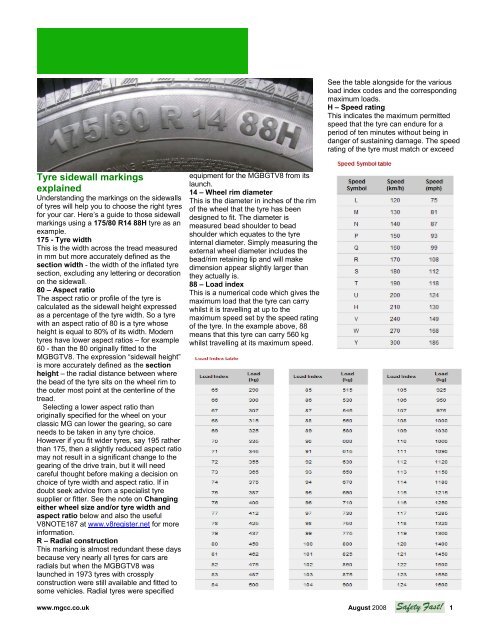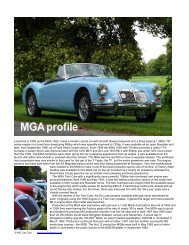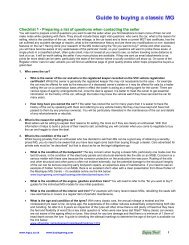Tyre sidewall markings explained - V8 Register
Tyre sidewall markings explained - V8 Register
Tyre sidewall markings explained - V8 Register
Create successful ePaper yourself
Turn your PDF publications into a flip-book with our unique Google optimized e-Paper software.
See the table alongside for the various<br />
load index codes and the corresponding<br />
maximum loads.<br />
H – Speed rating<br />
This indicates the maximum permitted<br />
speed that the tyre can endure for a<br />
period of ten minutes without being in<br />
danger of sustaining damage. The speed<br />
rating of the tyre must match or exceed<br />
<strong>Tyre</strong> <strong>sidewall</strong> <strong>markings</strong><br />
<strong>explained</strong><br />
Understanding the <strong>markings</strong> on the <strong>sidewall</strong>s<br />
of tyres will help you to choose the right tyres<br />
for your car. Here’s a guide to those <strong>sidewall</strong><br />
<strong>markings</strong> using a 175/80 R14 88H tyre as an<br />
example.<br />
175 - <strong>Tyre</strong> width<br />
This is the width across the tread measured<br />
in mm but more accurately defined as the<br />
section width - the width of the inflated tyre<br />
section, excluding any lettering or decoration<br />
on the <strong>sidewall</strong>.<br />
80 – Aspect ratio<br />
The aspect ratio or profile of the tyre is<br />
calculated as the <strong>sidewall</strong> height expressed<br />
as a percentage of the tyre width. So a tyre<br />
with an aspect ratio of 80 is a tyre whose<br />
height is equal to 80% of its width. Modern<br />
tyres have lower aspect ratios – for example<br />
60 - than the 80 originally fitted to the<br />
MGBGT<strong>V8</strong>. The expression “<strong>sidewall</strong> height”<br />
is more accurately defined as the section<br />
height – the radial distance between where<br />
the bead of the tyre sits on the wheel rim to<br />
the outer most point at the centerline of the<br />
tread.<br />
Selecting a lower aspect ratio than<br />
originally specified for the wheel on your<br />
classic MG can lower the gearing, so care<br />
needs to be taken in any tyre choice.<br />
However if you fit wider tyres, say 195 rather<br />
than 175, then a slightly reduced aspect ratio<br />
may not result in a significant change to the<br />
gearing of the drive train, but it will need<br />
careful thought before making a decision on<br />
choice of tyre width and aspect ratio. If in<br />
doubt seek advice from a specialist tyre<br />
supplier or fitter. See the note on Changing<br />
either wheel size and/or tyre width and<br />
aspect ratio below and also the useful<br />
<strong>V8</strong>NOTE187 at www.v8register.net for more<br />
information.<br />
R – Radial construction<br />
This marking is almost redundant these days<br />
because very nearly all tyres for cars are<br />
radials but when the MGBGT<strong>V8</strong> was<br />
launched in 1973 tyres with crossply<br />
construction were still available and fitted to<br />
some vehicles. Radial tyres were specified<br />
equipment for the MGBGT<strong>V8</strong> from its<br />
launch.<br />
14 – Wheel rim diameter<br />
This is the diameter in inches of the rim<br />
of the wheel that the tyre has been<br />
designed to fit. The diameter is<br />
measured bead shoulder to bead<br />
shoulder which equates to the tyre<br />
internal diameter. Simply measuring the<br />
external wheel diameter includes the<br />
bead/rim retaining lip and will make<br />
dimension appear slightly larger than<br />
they actually is.<br />
88 – Load index<br />
This is a numerical code which gives the<br />
maximum load that the tyre can carry<br />
whilst it is travelling at up to the<br />
maximum speed set by the speed rating<br />
of the tyre. In the example above, 88<br />
means that this tyre can carry 560 kg<br />
whilst travelling at its maximum speed.<br />
www.mgcc.co.uk August 2008 1
the maximum speed of your car. See the<br />
table below for the maximum permitted<br />
speeds for each speed rating. Generally tyre<br />
speed ratings are in alphabetical order,<br />
however W and Y rated tyres are a special<br />
case as they can operate at higher maximum<br />
speeds than older Z rated tyres. It is<br />
therefore safe to replace your current Z rated<br />
tyres with W or Y rated tyres.<br />
Important note regarding load index and<br />
speed rating<br />
It is essential you do not fit tyres to your<br />
vehicle with a lower speed rating or load<br />
index than recommended by the vehicle<br />
manufacturer. Fitting lower speed rated tyres<br />
or tyres with a lower load index may<br />
invalidate your insurance. Although the UK<br />
speed limit is just 70mph, most vehicles are<br />
more than capable of exceeding this speed.<br />
Therefore vehicle insurance companies will<br />
insist that the tyres of the correct speed<br />
rating are fitted to your vehicle.<br />
E4 marking and DOT code<br />
The E4 marking is an ECE type approval<br />
mark which demonstrates the tyre has been<br />
tested as high quality by the European<br />
Regulatory Authorities. All tyres for use in<br />
the USA have the DOT code as required by<br />
the US Department of Transport (DOT). It<br />
specifies the company, factory, mould,<br />
batch, and date of production - 2 digits for<br />
the week of the year plus 2 digits for the<br />
year; or 2 digits for the month of the year<br />
plus 1 digit for the year for tyres made prior<br />
to 2000. So in the example above the 0508<br />
indicates that tyre was made in the fifth week<br />
of 2008.<br />
Additional information on the <strong>sidewall</strong> will<br />
include the manufacturer’s name and the<br />
country of origin. For asymmetric tyres<br />
the outer face of the tyre will have<br />
“outside” as an additional <strong>sidewall</strong><br />
marking.<br />
Earlier <strong>sidewall</strong> <strong>markings</strong>. Prior to<br />
1991, tyre speed ratings were shown<br />
between the tyre size and the "R"<br />
character in the case of a radial<br />
construction tyre. For example in the<br />
MGBGT<strong>V8</strong> Driver’s Handbook AKD<br />
8423 page 67 the recommended tyres<br />
were 175HR x 14 radial ply. Back in the<br />
early 1970s the available codes were<br />
SR (112 mph, 180 km/h), HR (130 mph,<br />
210 km/h), VR (in excess of 130 mph,<br />
210 km/h) and ZR (in excess of 149<br />
mph, 240 km/h). The ZR code is still in<br />
common use, often combined with a W<br />
or Y speed code.<br />
Changing either wheel size and/or<br />
tyre width and aspect ratio<br />
When considering changing either<br />
wheel or tyre sizes, it is necessary to<br />
retain an overall diameter (wheel rim<br />
diameter plus the tyre sections) which is<br />
as close as possible to the original if the<br />
gearing of the drive train is to be<br />
maintained. Changing the overall<br />
diameter will also alter the ride height.<br />
There is a very useful <strong>Tyre</strong> Size<br />
Change Calculator on the etyres<br />
website which can help you.<br />
http://www.etyres.co.uk/tyre-sizecalculator.htm<br />
Of course some people might wish to<br />
make changes by using different wheel<br />
and tyre combinations. If the overall<br />
gearing of the vehicle is significantly<br />
changed as a consequence, then the<br />
speedometer will have to be recalibrated<br />
to suit. If wider tyres are fitted, remember<br />
to check that they do not foul the wheel<br />
arches under any conditions. Turning up<br />
the lip of the wheel arch may help. If<br />
advantage is taken of modern tyre<br />
compounds or wider tyres to increase<br />
cornering speeds, this will increase the<br />
load on the front wheel bearings,<br />
amongst other components, and these<br />
should be regularly checked.<br />
Contributors: This note has been<br />
prepared by Victor Smith with helpful<br />
contributions from John Bolt, Gordon<br />
Hesketh-Jones, Chris Hunt Cooke, Geoff<br />
King, Bob Owen, Ian Quarrington and<br />
Dave Wellings.<br />
www.mgcc.co.uk August 2008 2





